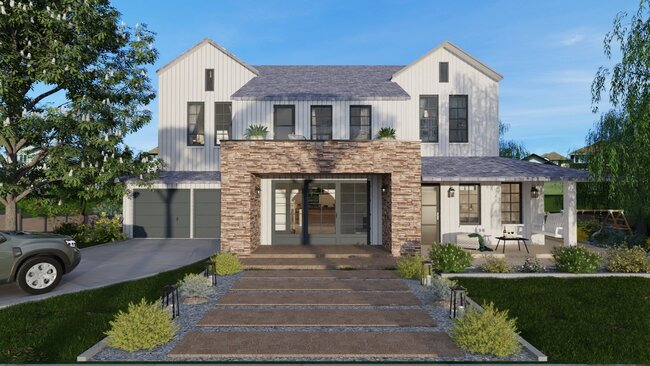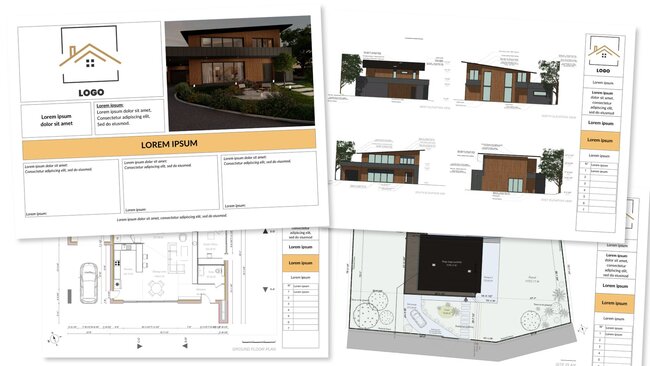There are two critical facets of an architect’s success: the quality of their work and the quality of their presentation. Effectively communicating and translating your ideas to clients through a concise, creative pitch allows you to win business and grow your firm. However, many mistakes during this presentation can hold you back.
Today, we’ll review five common architectural presentation mistakes and how to avoid them. This will help you package your ideas into a digestible and inspiring pitch that gets you a “yes.”
The Architectural Design Presentation Process

Architects must prepare to communicate their unique approach and vision to their clients—that’s where a strong presentation comes in.
The presentation process often unfolds in several steps, including:
- Research and brainstorming: Here, the architect immerses themselves in the client’s brief, dissecting project-specific requirements such as the scope, unique site layout, regulations, budget, and creative direction.
- Concept development: Once the architect understands the brief, they ideate a creative vision for the project, which could include rough sketches, mood boards, and initial design inspiration.
- Design development: At this point, the architect will translate their creative vision into concrete deliverables such as 3D renderings, floor plans, and other site-specific plans.
With all of these deliverables, the architect must compile a compelling slide deck to present their ideas to the client. Doing so is much easier said than done.
Mistakes when Presenting Architecture Projects
You could have an incredible idea and a one-of-a-kind vision, but if you can’t communicate that to your clients, you won’t win the business. Let’s review the architecture presentation mistakes that could stand in your way.
1. There’s Too Much (Or Not The Right) Information
When building your ideas, you’re in the weeds of the project, making it easy to get lost in the minutia and inundating the client with information they don’t need. Doing so can muddle your vision and leave the client unsure of the big picture.
For example, say you have six different tactics for fulfilling the brief. If you spend 30 minutes diving into the functional execution of each approach and fill the slide deck with charts, graphs, and other research, the client may lose sight of the project goal and feel too overwhelmed to make a decision.
During your presentation, strike the right balance between your high-level approach and a precise plan for executing it. To do this:
- Communicate the project goal
- Give a concise overview of the creative approach
- Use appropriate visuals and renderings to overview how this vision can be accomplished
2. The Images Aren’t Compelling

In design, words only go so far. It’s the visuals that enhance the pitch and immerse the client in your ideas. But too often, presentations are riddled with blurry, pixilated, watermarked, or even irrelevant images.
Poor image quality isn’t doing you any favors. Including amateur images can sully your presentation, dampen the aesthetic, and dim client enthusiasm for your (fantastic) ideas.
Instead of using images to simply fill space, consider the role the image plays in the slide. What idea is it communicating? How is it enhancing your delivery? What mood is it inspiring in your audience?
Using high-quality, relevant images can take your presentation to the next level. Consider including visuals like:
- 3D plans
- 3D renderings
- Architectural drawings
- Design inspiration photos
3. The Presentation Has An Inconsistent Style

A warm-toned color palette on slide one. A cool-toned color palette on slide two. A new font on slide five. A different image format on slide nine. This disjointed visual approach is a big mistake for architecture design presentations because it jolts the viewer and pulls them outside the world you’re creating. There’s also no clear sense of brand identity and continuity.
In addition to the visual disruption, it can confuse your audience, making them lose focus on your key ideas and theme. These inconsistencies may also communicate a lack of preparedness and cause doubt that you’re the right firm to tackle the job.
There are ways to make each slide creative while ensuring visual cohesion:
- Use a template that standardizes document orientation, formatting, and margins.
- Select a visual approach for using images and graphic elements—placement, formatting, etc.
Customize the slides to match your brand colors.
4. You’re Not Interacting With Your Audience
It’s hard to keep your audience’s attention in a presentation. In fact, more than four out of five people focused on something other than the speaker in the most recent presentation they watched.
Remember, you’re not presenting to your computer (or your slide deck)—you’re presenting to people. A common mistake architects make when presenting work to clients is not leaving room for engagement and interaction during the presentation.
While you want to remain efficient, an architecture presentation without audience participation can feel stale and lifeless. Including open-ended questions, videos, polls, animations, and natural space for feedback breathe life into your presentation and encourage open communication.
Your delivery is a big part of this being successful. Avoid staring at the slides and simply reading the text to your audience verbatim. Doing so doesn’t provide added value. Instead, let the slides be a launching-off point for the narrative you’ve constructed for your presentation.
Trust that you’ve done your homework and know the material enough to look up from your notes, make eye contact with your audience, and have the slides simply complement your well-crafted approach.
5. You Rely On Grocery Lists To Communicate Your Ideas
Architects, leave the grocery lists for your Sunday meal prep, not your client presentations. We’ve all been privy to this experience—staring at a slide with a string of short words or phrases arranged in bullet points.
While the content might be spot-on, the delivery is a bit lackluster. Placing your ideas in a bulleted list may at first appear efficient, but it misses the visual aids that bring your idea to life, like graphs, renderings, charts, and inspiration images.
Plus, it exposes you to two important presentation delivery problems:
- You reading directly from the slide.
- Your audience trying too hard to read every word that they miss what you’re talking about.
Consider more creative ways to communicate your message, such as using images and detailed models instead of bullet points. Or writing down the most significant bits of text and discussing the rest.
Tips for Presenting
As you can see, several architectural presentation mistakes can taint your pitch.
In addition to the presentation dos and donts we discussed above, here are some extra tips to help you nail your next pitch:
- Come with options: Including a few curated approaches for executing your vision helps your clients see the possibilities regarding creative vision, price points, and more.
- Know your numbers: “So what will that cost?” You can rest assured your clients will ask you this question. Bring a high-level and detailed cost breakdown of your recommendations for price transparency.
- Leave them wanting more: Remember, you want to balance high-level vision with specific details, and this includes knowing which details to exclude from this initial pitch. Be sure to provide enough information to keep the client interested without giving away your entire strategy.
- Bring your A-game: Confidence is more than half the battle when it comes to presentations. Trust in yourself and your team’s audience research, site research, and creative vision. Leading with confidence and excitement will make the presentation more engaging.
Actively listen: If your client has a question, concern, or idea, actively hear them and listen to them throughout your presentation. Picking up on these cues can help you pivot in real-time and tailor your delivery according to the temperature of that room.
Get Designing with Cedreo Today!
Designing a presentation that impresses your clients quickly can be tough. Cedreo can help. Our presentation software makes it easy for architects, builders, and designers to create documents that reflect their vision faster. Try it for yourself to turn your architecture presentation mistakes into magic.



